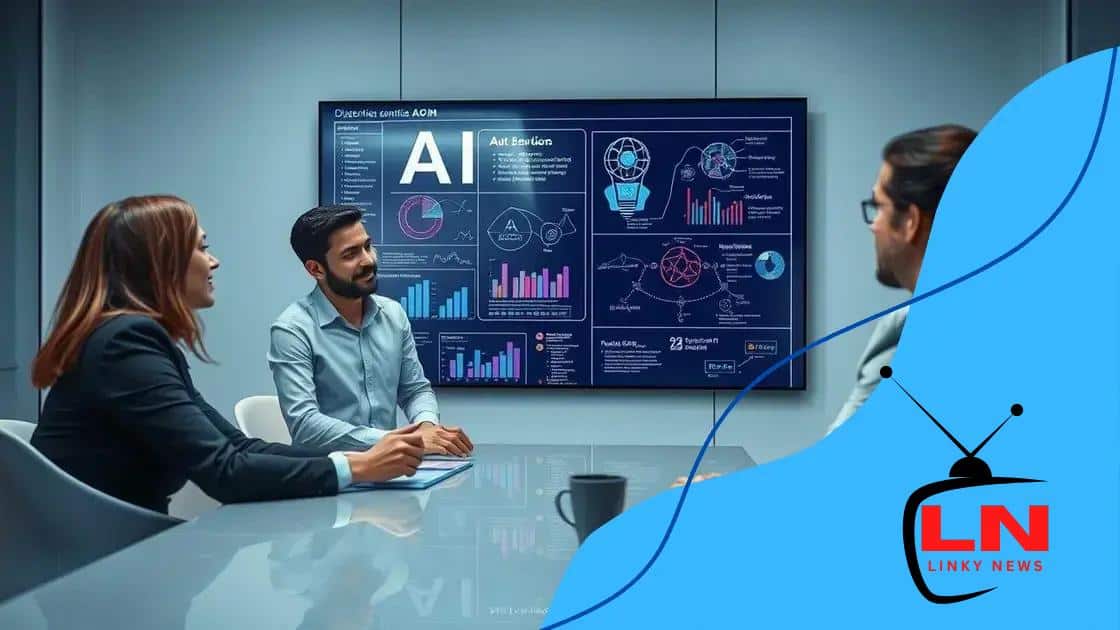AI in benefits management: unlocking organizational potential

AI in benefits management enhances employee engagement through personalized offerings, improves administrative efficiency via automation, and utilizes data analytics for informed decision-making, ensuring organizations meet evolving workforce needs.
AI in benefits management is transforming the way organizations approach employee benefits. Are you ready to explore how this innovative technology can streamline processes and improve decision-making?
Understanding AI in benefits management
Understanding AI in benefits management is essential for organizations looking to improve their operational efficiency. By leveraging artificial intelligence, companies can streamline processes and enhance decision-making regarding employee benefits.
What is AI in Benefits Management?
AI in benefits management refers to the use of machine learning and algorithms to analyze data related to employee benefits. This technology can help organizations identify trends, optimize benefits offerings, and ensure compliance with regulations.
Key Features of AI in Benefits Management
Some key features include:
- Automated data analysis to simplify decision-making.
- Predictive analytics to forecast employee needs and engagement.
- Personalization of benefits packages based on employee preferences.
By incorporating these features, companies can adapt swiftly to changing employee expectations. Moreover, AI systems can gather and process large volumes of data quickly, providing insights that would take humans much longer to analyze.
Additionally, AI technologies can enhance the communication process within organizations. For instance, chatbots driven by AI can answer employee queries about benefits, making information readily accessible. This ensures that employees are well-informed about their options, leading to higher satisfaction rates.
Understanding the role of AI in benefits management is crucial for organizations aiming to stay competitive. By embracing these innovations, businesses can create a more effective benefits management strategy that aligns with employee needs and enhances overall productivity.
Key advantages of incorporating AI technologies
Key advantages of incorporating AI technologies in benefits management are numerous and impactful. By adopting AI, organizations can achieve enhanced efficiency and data-driven decision-making.
Improved Efficiency
One of the main advantages is the ability to automate repetitive tasks. This reduces the workload on HR teams, allowing them to focus on strategic activities.
- Streamlined processes save time and resources.
- Automated systems can manage benefits enrollment faster.
- Real-time data access helps in quick decision-making.
As a result, companies experience increased productivity across the board.
Data-Driven Insights
AI enhances the capacity to analyze vast amounts of data. Organizations can gain valuable insights into employee preferences and behaviors, guiding tailored benefits.
For example, predictive analytics can forecast trends, helping HR plan better. This data-oriented approach supports creating customized benefits packages that align with employee needs.
Furthermore, AI can identify areas where employees may be underutilizing their benefits. By addressing these gaps, employers can encourage higher engagement and satisfaction.
Utilizing AI technologies also facilitates compliance by automatically updating changes in regulations related to employee benefits.
Ultimately, embracing AI leads to a well-rounded benefits management system that fosters positive outcomes for both employees and organizations.
Best practices for AI implementation

Best practices for AI implementation are critical for organizations aiming to harness the power of artificial intelligence effectively. By following these guidelines, companies can ensure a smooth integration of AI technologies into their benefits management processes.
Assess Your Needs
Before diving into AI solutions, it’s essential to evaluate your organization’s specific needs. Identify the areas where AI can add value, such as improving efficiency or enhancing employee engagement. A clear understanding of your objectives helps in selecting the right tools and technologies.
Choose the Right Technology
Not all AI technologies are created equal, so select tools that align with your organizational goals. Consider:
- Scalability of the technology to accommodate future growth.
- User-friendliness for easy employee adoption.
- Integration capabilities with existing systems.
This thoughtful selection process will contribute to a successful AI rollout.
Data quality is another critical factor. Ensure you have accurate and relevant data to feed into AI systems. Poor data quality can lead to unreliable insights and hinder decision-making.
Furthermore, training your workforce is vital. Provide necessary training sessions to help employees understand and engage with AI tools. This training can enhance productivity and ease any resistance to change.
Lastly, continuously monitor and optimize your AI systems. Regularly assess the effectiveness of AI implementations and be ready to make adjustments as needed. Collect feedback from users to understand their experiences and identify areas for improvement.
By adhering to these best practices, organizations can maximize the advantages of AI in benefits management and create a more cohesive strategy.
Measuring the impact of AI on benefits
Measuring the impact of AI on benefits is crucial for understanding the effectiveness of implementations and guiding future decisions. Organizations need to establish clear metrics to evaluate AI’s contributions to benefits management.
Key Performance Indicators (KPIs)
To assess the impact of AI on benefits, companies should focus on relevant key performance indicators. Here are some important KPIs to consider:
- Employee engagement rates with benefits.
- Efficiency improvements in benefits enrollment processes.
- Cost savings realized through AI-driven analytics.
By tracking these indicators, organizations can gain insights into how AI technologies are reshaping their benefits management.
Data Analytics
Utilizing data analytics plays an essential role in measuring outcomes. AI tools can analyze engagement data to provide real-time feedback on employee satisfaction and usage of benefits. Insights from this data allow HR teams to make informed changes to benefits offerings.
For example, if analysis shows low engagement in a specific health benefit, HR can work on improving awareness or education. This targeted approach ensures that employees receive the support they need.
Moreover, tracking financial metrics, such as reductions in administrative costs, helps gauge the ROI of integrating AI technologies. Companies can measure whether the costs of implementation outweigh the benefits gained.
It’s also valuable to gather employee feedback periodically. Surveys can assess perceptions of AI-facilitated benefits management, offering qualitative data to complement quantitative metrics.
Ultimately, by thoughtfully measuring the impact of AI on benefits, organizations can refine their strategies and improve overall employee satisfaction.
Future trends in AI and benefits management
Future trends in AI and benefits management are shaping how organizations will approach employee benefits. As technology evolves, the integration of AI continues to open up new possibilities.
Increased Personalization
One major trend is the move towards increased personalization of benefits packages. AI can analyze employee data to recommend tailored benefits that align with individual preferences. This personalization not only boosts engagement but also enhances employee satisfaction.
Predictive Analytics
Another evolving trend is the use of predictive analytics. By leveraging historical data, AI can forecast future needs in benefits management. This foresight allows companies to proactively adjust their benefits offerings based on anticipated employee demands.
- Identifying trends in employee health and wellness.
- Forecasting shifts in the labor market.
- Assessing the potential impact of new benefits legislation.
By integrating these analytics, organizations can stay ahead of the curve.
Moreover, machine learning algorithms will continue to improve. These algorithms will enhance decision-making processes, allowing HR teams to make data-driven choices about benefits design and administration.
AI-driven automation will streamline processes further. Tasks such as benefits enrollment, claims processing, and compliance checks will become even more efficient. This shift frees up HR personnel to focus on strategic initiatives rather than administrative tasks.
Finally, integration between AI and other emerging technologies, such as blockchain, will transform benefits management. This combination can enhance security and transparency, especially concerning sensitive employee data.
Overall, the future of AI and benefits management promises enhanced efficiency, greater personalization, and improved outcomes for both employers and employees.
FAQ – Frequently Asked Questions about AI in Benefits Management
How does AI improve employee benefits management?
AI enhances employee benefits management by providing data-driven insights, automating tasks, and personalizing benefits packages based on individual employee needs.
What are some key benefits of using AI in this area?
Key benefits include increased efficiency in benefits administration, improved employee satisfaction through tailored offerings, and enhanced compliance with regulations.
How can I measure the impact of AI on my organization’s benefits?
You can measure impact through key performance indicators (KPIs) such as employee engagement rates, cost savings, and the efficiency of benefits enrollment processes.
Is AI technology expensive to implement?
The cost of AI implementation varies, but there are many scalable and affordable solutions available that can greatly benefit organizations of all sizes.





